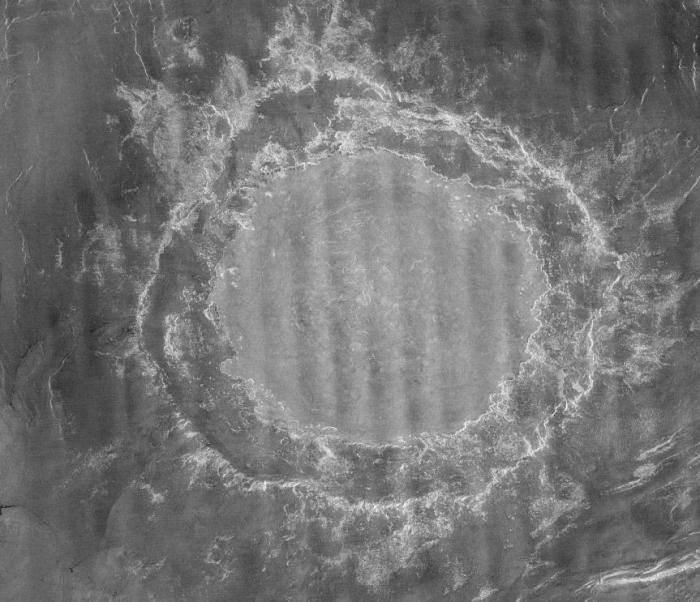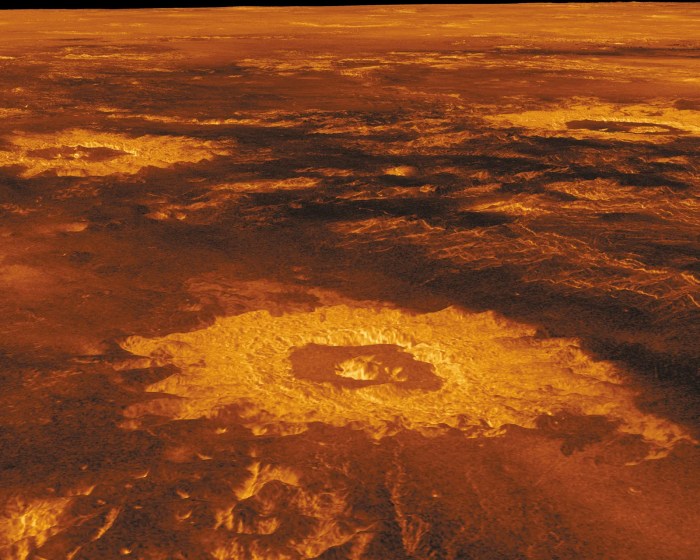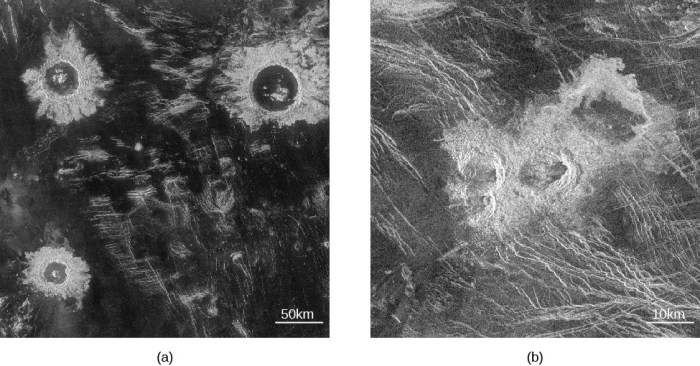With craters on Venus astro 7n at the forefront, this article delves into the captivating world of impact cratering on Venus, offering a unique perspective on the planet’s geological evolution and its place in our solar system.
Venus, our neighboring planet shrouded in a thick, opaque atmosphere, holds a treasure trove of information about its past, etched in the countless craters that adorn its surface. These impact scars, ranging from small, shallow depressions to massive, complex structures, provide a window into the planet’s dynamic history and its interactions with celestial bodies.
Crater Distribution and Density: Craters On Venus Astro 7n

Venus exhibits a relatively uniform distribution of craters across its surface, with no significant variations in crater density between different regions. This suggests that the planet has experienced a relatively consistent rate of impact bombardment throughout its history.However, there are some notable exceptions to this general pattern.
For instance, the northern hemisphere of Venus has a slightly higher concentration of craters than the southern hemisphere. This asymmetry may be due to the planet’s rotation, which deflects incoming projectiles towards the poles.Additionally, there are a few regions on Venus that have unusually high crater densities.
For astronomy buffs, “craters on venus astro 7n” is a topic that sparks curiosity. To understand the mathematical aspects of crater formation, one can delve into the insights shared by “nicole the math lady 7/6” ( nicole the math lady 7/6 ). By exploring the fascinating world of craters on Venus, we can unravel the mysteries of our neighboring planet and gain a deeper appreciation for the celestial tapestry that surrounds us.
These regions are typically associated with volcanic activity, which may have disrupted the surface and created new craters.
Crater Morphology and Characteristics
Venus exhibits a diverse array of craters, each possessing unique morphological features that provide valuable insights into the planet’s geological history and surface processes. Understanding the morphology and characteristics of these craters is crucial for deciphering Venus’s complex geological evolution.
Simple Craters
Simple craters are the most prevalent type on Venus, accounting for approximately 80% of all craters. They are characterized by their relatively small size, ranging from 1 to 10 kilometers in diameter. Simple craters typically have a bowl-shaped morphology, with a central peak or pit in some cases.
Ejecta deposits are usually confined to the crater rim and immediate surroundings.
Complex Craters
Complex craters are larger than simple craters, ranging from 10 to 100 kilometers in diameter. They exhibit a more complex morphology, with a central peak or ring surrounded by a series of concentric rings. The ejecta deposits are more extensive and may extend for hundreds of kilometers from the crater rim.
Peak-Ring Craters
Peak-ring craters are a unique type of complex crater found exclusively on Venus. They are characterized by a central peak surrounded by a series of concentric rings, but unlike typical complex craters, they lack a central pit. Peak-ring craters are typically large, ranging from 50 to 200 kilometers in diameter.
Factors Influencing Crater Morphology
The morphology of craters on Venus is influenced by several factors, including the impact velocity, impact angle, target material properties, and atmospheric conditions. Higher impact velocities and lower impact angles tend to produce larger craters with more complex morphologies. The target material’s strength and composition also play a role, with stronger materials producing smaller craters with simpler morphologies.
Crater Formation Processes

The Venusian surface is scarred by numerous craters, providing valuable insights into the planet’s geologic history. These craters are primarily formed through impact events, involving the collision of asteroids or comets with the planet’s surface.
When an impactor strikes the surface, its kinetic energy is released, generating a shockwave that propagates through the ground. This shockwave causes the ground to compress and deform, creating a crater. The size and shape of the crater depend on various factors, including the impactor’s size, velocity, and angle of impact, as well as the properties of the surface material.
Impact Cratering Process
The impact cratering process on Venus involves several distinct stages:
- Initial Contact and Compression:Upon impact, the impactor compresses the surface material, creating a small crater.
- Shockwave Propagation:A shockwave radiates outward from the impact point, causing the ground to deform and fracture.
- Crater Excavation:As the shockwave dissipates, the excavated material is ejected outward, forming an ejecta blanket around the crater.
- Crater Modification:Over time, the crater undergoes various modifications, such as relaxation of the crater walls and infilling by sediment.
The impact cratering process on Venus has significantly shaped the planet’s surface, creating a diverse range of crater morphologies and characteristics.
Crater Chronology and Dating
Determining the age of craters on Venus is a complex task due to the planet’s unique geological history and the challenges in obtaining data. Despite these difficulties, scientists have developed several techniques to estimate the age of craters on Venus.
Radiometric Dating
Radiometric dating is a technique that uses the decay of radioactive isotopes to determine the age of rocks and minerals. This method is not widely used on Venus because of the lack of suitable samples and the challenges in obtaining accurate measurements.
Crater Size-Frequency Distribution, Craters on venus astro 7n
The crater size-frequency distribution (CSFD) is a statistical analysis of the number and size of craters in a given area. The CSFD can be used to estimate the relative age of a surface, with younger surfaces having a higher proportion of small craters and older surfaces having a higher proportion of large craters.
Stratigraphic Relationships
Stratigraphic relationships refer to the order in which rock layers are deposited. By studying the relationships between craters and other geological features, scientists can determine the relative age of different surfaces on Venus.
Challenges in Crater Dating on Venus
Dating craters on Venus presents several challenges, including:
- The lack of water and tectonic activity on Venus has resulted in a relatively pristine surface, with few erosion or deformation processes to disturb the craters.
- The thick atmosphere of Venus makes it difficult to obtain high-resolution images of the surface, which can limit the accuracy of crater measurements.
- The harsh conditions on Venus make it difficult to obtain samples for radiometric dating.
Current Understanding of the Crater Chronology of Venus
Despite the challenges, scientists have made significant progress in understanding the crater chronology of Venus. The oldest craters on Venus are estimated to be around 4 billion years old, while the youngest craters are thought to have formed within the past few million years.
The crater density on Venus is relatively low compared to other planets in the solar system, indicating that the surface has been resurfaced relatively recently. This resurfacing is thought to have been caused by volcanic activity, which has covered up older craters and created a relatively young surface.
Crater-Related Features

In addition to the craters themselves, impact events on Venus can produce a variety of secondary features, including ejecta deposits, melt flows, and central peaks. These features provide valuable insights into the impact process and the history of Venus’ surface.
Ejecta Deposits
Ejecta deposits are composed of material that has been ejected from the crater during the impact event. They can extend for hundreds of kilometers from the crater rim and can be several kilometers thick. Ejecta deposits can be classified into several types, including continuous ejecta, discontinuous ejecta, and ejecta rays.
Continuous ejecta deposits form a continuous blanket of material around the crater. They are typically composed of fine-grained material, such as dust and ash, and can be several meters thick. Discontinuous ejecta deposits are composed of larger fragments of material, such as rocks and boulders.
They are typically found in the vicinity of the crater rim and can be several kilometers thick.
Ejecta rays are narrow, linear features that extend radially from the crater. They are composed of fine-grained material and are thought to be formed by the ejecta curtain that is produced during the impact event.
Melt Flows
Melt flows are composed of molten material that has been ejected from the crater during the impact event. They can extend for tens of kilometers from the crater rim and can be several meters thick. Melt flows are typically composed of basaltic material and are thought to be formed by the melting of the target material by the heat of the impact.
Central Peaks
Central peaks are conical or dome-shaped features that are located in the center of some craters. They are typically composed of uplifted material from the crater floor and can be several kilometers high. Central peaks are thought to be formed by the rebound of the crater floor after the impact event.
Impact Cratering and Planetary Evolution

Impact cratering is a fundamental process that has shaped the surface of Venus and influenced its geological and evolutionary history. The study of impact craters provides valuable insights into the planet’s surface processes, geological evolution, and the role of impact events in shaping the solar system.
Venus exhibits a unique impact cratering record that differs from other planets in the solar system. The planet’s thick and dense atmosphere, along with its slow rotation and lack of tectonic activity, have resulted in a distinct crater distribution and morphology.
Comparison of Impact Cratering Records
Compared to other planets in the solar system, Venus has a relatively low crater density. This is primarily due to the planet’s thick atmosphere, which acts as a protective shield against smaller impactors. The atmosphere decelerates and vaporizes many small meteoroids and asteroids, preventing them from reaching the surface.
However, Venus also has a significant population of large craters, particularly in the northern hemisphere. These craters are likely the result of impacts by large asteroids or comets that were able to penetrate the atmosphere and strike the surface.
The distribution of craters on Venus is also unique. Craters are concentrated in certain regions, such as the northern hemisphere and the equatorial highlands. This suggests that these areas may have been more susceptible to impact events or that the surface has been resurfaced in other regions.
Implications for Understanding Venus’ History
The study of impact craters on Venus has provided important insights into the planet’s geological and evolutionary history.
- Crater Ages:By dating impact craters, scientists can determine the age of the surface and estimate the rate of crater formation over time.
- Surface Processes:The morphology and distribution of craters can provide information about the surface processes that have occurred since the impact event, such as erosion, volcanism, and tectonic activity.
- Planetary Evolution:Impact craters can serve as a record of major events in the planet’s history, such as large-scale volcanic eruptions, global resurfacing events, and the formation of the atmosphere.
By combining data from impact craters with other geological observations, scientists can gain a comprehensive understanding of Venus’ surface processes, geological evolution, and its place in the solar system.
Query Resolution
What is the significance of studying craters on Venus?
Craters on Venus provide valuable information about the planet’s geological history, impact cratering processes, and its interactions with celestial bodies.
How do scientists determine the age of craters on Venus?
Scientists use various techniques to determine the age of craters on Venus, including crater size-frequency distribution, crater morphology, and surface stratigraphy.
What are the implications of impact cratering for planetary evolution?
Impact cratering has played a significant role in shaping the surface and geological evolution of Venus, contributing to the formation of mountains, volcanoes, and other surface features.